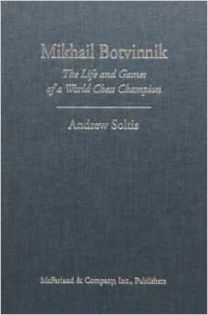Mikhail Botvinnik
The Life and Games of a World Chess Champion
Andy Soltis

The question of who is the greatest player of all time will likely never be answered. Not so which World Champion has the most books devoted to them. According to lists compiled by Edward Winter its not even close. The winner is Bobby Fischer with over 100 books written on him, roughly double that of second place Garry Kasparov. Weve seen no list of who might be third but our guess would be Mikhail Tal followed by Mikhail Botvinnik. The latter deserves mention because most of the books on him were not only written by the Patriarch but also quite lengthy. One need only recall the three-volume work by Baturinsky and a later trilogy (plus one volume autobiography) by Botvinnik himself.
The above works were all originally published in Russian but there is much on Botvinniks life and games in English as well which might cause one to wonder if there was a need for Grandmaster Andy Soltiss latest work, MIKHAIL BOTVINNIK: THE LIFE AND GAMES OF A WORLD CHESS CHAMPION.
The 88 games which appear in this book cover Botvinniks career from its beginnings in 1924 to his last event in 1970, but they are not all that Soltis has to offer. What makes MIKHAIL BOTVINNIK: THE LIFE AND GAMES OF A WORLD CHESS CHAMPION compelling reading is the insights the author offers on Botvinnik the man.
Sure, the Patriarch wrote about his life in his books, particularly ACHIEVING THE AIM. If one wants Botvinniks take on the various episodes in his life this is the book to read but those looking for a more balanced and nuanced treatment will want other sources and this is where Soltis shines. His wide knowledge of Russian chess history allows him to put things in perspective.
One learns that Botvinnik was a true believer in the Communist system, a real Homo Soveticus, but that didnt stop him from occasionally butting heads with the authorities. More often he used his power and influence (blat) to arrange things to his liking. This was particularly true when it came to arrangements for World Champion matches.
The 1961 return match with Tal is a well-known example of Botvinniks tough negotiating style. Tals doctors in Riga wanted to postpone the start of the match for two months due to the new World Champion bad health. Botvinniks response was to ask for Tal to come to Moscow and be examined by independent doctors. This behavior is consistent with the well-known observation that Botvinnik found it necessary to actively dislike his opponent in order to play his best.
Tal was not the only World Champion that Botvinnik faced who was not at their best. Soltis quotes Smyslov that during his third match with Botvinnik …I was struck by a strong case of the flu. His temperature reached the equivalent of 102 degrees Fahrenheit and he was taking antibiotics. When the match ended, he said, he spent the next two weeks in bed.
This is a book on Botvinnik and not Smyslov but one question I was hoping to have answered was how the death of Smyslovs stepson, Vladimir Selimanov, affected Vassily Vasilyevich. Selimanov was the Soviet representative in the 1957 World Junior Championship in Toronto, held in August 1957, only a few months after Smyslov became world champion. Selimanov finished fourth in the event.
Soltis, writing in the NY Post on April 4th, 2010, not long after Smyslovs death had this to say:
At that time, such a performance was viewed almost as treason to the motherland, wrote an interviewer on the site president.org.ua on March 26, 2008, noting that Smyslov and his wife never talk of what happened to Vladimir next: Soon after his return, he killed himself.
William Lombardy, who won the 1957 World Junior with a perfect score, has a different explanation for what caused Selimanov to take his life. Writing in his book UNDERSTANDING CHESS: MY SYSTEM, MY GAMES, MY LIFE (2011) he says that the 18-year-old Selimanov fell in love with a Canadian lady during the event and wanted to marry her but was forced to return alone back to the Soviet Union.
Whatever the reason for Selimanovs death, this had to be a devastating blow for Smyslov who defended his title in March 1958. One cant recall another World Champion match participant who suffered such a horrible personal tragedy so close to a match. Note that this is conditional on Selimanov dying in late 1957 or early 1958. I was not able to find a date of death online. Gennadi Sosonko, who writes extensively about Smyslov in his excellent The World Champions I Knew, has nothing to say about this sad story.
Soltis points out that amazingly enough Botvinniks win over Smyslov in 1958 was the first match he won since 1940! This makes sense once you give it some thought (a drawn match with Smyslov and a loss to Smyslov) but its not something that immediately comes to mind. Such observations by the author help to make this book come alive.
Botvinniks impact on the chess world, not only as a player but also as annotator where his long-term impact might be even greater, is dealt with at length by Botvinnik. Today strong chess engines correct the analysis of all players be they mortals or World Champions, but Botvinniks explanations of how to play certain positions are still valuable today, more than 40 years after he played his last tournament game.
The role of Botvinnik as a chess teacher is also covered. The close connection between Botvinnik and Kasparov is discussed as is the lack of any strong connection between Karpov and the Patriarch, who did not think much of the young Anatoly.
MIKHAIL BOTVINNIK: THE LIFE AND GAMES OF A WORLD CHESS CHAMPION is a fascinating book that is must reading for anyone wishing to learn more about this fascinating figure.
